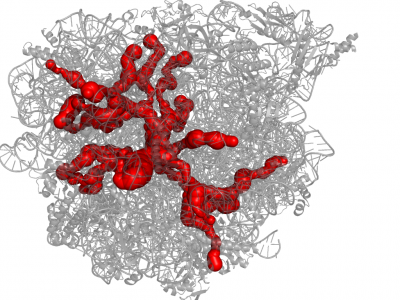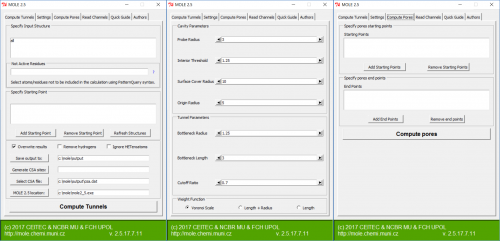Difference between revisions of "MOLE 2.0: advanced approach for analysis of biomacromolecular channels"
LukasPravda (talk | contribs) m (typos correction) |
LukasPravda (talk | contribs) m (wrong url corrected) |
||
| Line 1: | Line 1: | ||
| − | [[File:Molelogo.png|80px|left|]] [[File:1jj2.png|400px|thumb|right|Example of channel system of 1JJ2]] [http://mole.chemi.muni.cz MOLE 2.0] is a successor of a popular software tool [http://lcc.ncbr.muni.cz/whitezone/development/mole/web/index.php Mole] for detection and characterization of channels in biomacromolecules (proteins, nucleic acids and glycans). This completely redesigned version allows user rapid and accurate '''analysis of channels and transmembrane pores''' even ''' in large structures''' (hundreds of thousands of atoms). As a new feature, MOLE 2.0 '''estimates''' not only '''physicochemical properties''' of the identified channels, i.e., '''hydropathy, hydrophobicity, polarity, charge, and mutability''', but also physicochemical properties of the cavities. For thorough description of the functionality and instructions on working with MOLE 2.0 please consult the [http://doi | + | [[File:Molelogo.png|80px|left|]] [[File:1jj2.png|400px|thumb|right|Example of channel system of 1JJ2]] [http://mole.chemi.muni.cz MOLE 2.0] is a successor of a popular software tool [http://lcc.ncbr.muni.cz/whitezone/development/mole/web/index.php Mole] for detection and characterization of channels in biomacromolecules (proteins, nucleic acids and glycans). This completely redesigned version allows user rapid and accurate '''analysis of channels and transmembrane pores''' even ''' in large structures''' (hundreds of thousands of atoms). As a new feature, MOLE 2.0 '''estimates''' not only '''physicochemical properties''' of the identified channels, i.e., '''hydropathy, hydrophobicity, polarity, charge, and mutability''', but also physicochemical properties of the cavities. For thorough description of the functionality and instructions on working with MOLE 2.0 please consult the [http://dx.doi.org/10.1186/1758-2946-5-39 paper] or our [http://webchem.ncbr.muni.cz/Platform/AppsBin/Mole2_manual.pdf manual]. |
Revision as of 06:50, 22 September 2013
MOLE 2.0 is a successor of a popular software tool Mole for detection and characterization of channels in biomacromolecules (proteins, nucleic acids and glycans). This completely redesigned version allows user rapid and accurate analysis of channels and transmembrane pores even in large structures (hundreds of thousands of atoms). As a new feature, MOLE 2.0 estimates not only physicochemical properties of the identified channels, i.e., hydropathy, hydrophobicity, polarity, charge, and mutability, but also physicochemical properties of the cavities. For thorough description of the functionality and instructions on working with MOLE 2.0 please consult the paper or our manual.
Availability and Requirements
MOLE 2.0 is available as a GUI application with in-built molecular browser enabling user interactive work; command-line application and PyMOL plugin. Some functionality is also available via online web service.
- GUI application is available for Windows with .NET 4.0 framework or newer installed.
- Command-line application and PyMOL plugin are available for Windows, Linux (Unix) and MacOS. For Linux (Unix) and MacOS systems Mono framework 2.10 or newer.
References
- Sehnal D, Svobodová Vařeková R, Berka K, Pravda L, Navrátilová V, Banáš P, Ionescu C-M, Otyepka M, Koča J: MOLE 2.0: advanced approach for analysis of biomacromolecular channels. Journal of Cheminformatics 2013, 5:39.
- Berka K, Hanák O, Sehnal D, Banáš P, Navrátilová V, Jaiswal D, Ionescu C-M, Svobodová Vařeková R, Koča J, Otyepka M: MOLEonline 2.0: interactive web-based analysis of biomacromolecular channels. Nucleic acids research 2012, 40:W222–7.


